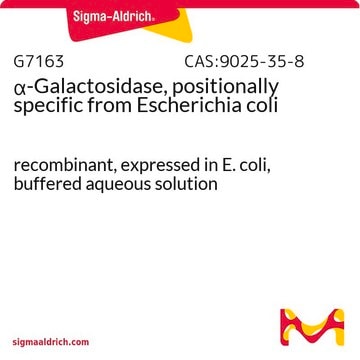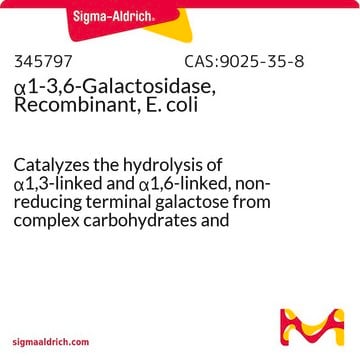おすすめの製品
リコンビナント
expressed in E. coli
アッセイ
≥85% (SDS-PAGE)
フォーム
lyophilized solid
比活性
≥20 units/mg protein
分子量
apparent mol wt ~84 kDa by SDS-PAGE
輸送温度
wet ice
保管温度
−20°C
詳細
Alkaline α-Galactosidase I is a glycoside hydrolase, separated from the extracts of melon fruits. The activity of this enzyme is found to increase during the early stages of ovary development and fruit set.[1]
アプリケーション
Alkaline α-Galactosidase I was used to assay enzyme activity with 2 mmp-nitrophenyl-α-d-galactoside as substrate at pH 6.5 to compare with the enzyme activity of α-Gal A isolated and purified from Sf-9 insect cells infected with a recombinant baculovirus encoding normal α-Gal A gene.[2]
生物化学的/生理学的作用
α-Galactosidase form I from melon may play a significant role in photoassimilate partitioning in sink tissue. The form I enzyme has a preferred activity with raffinose and significant activity with stachyose. A unique feature of this enzyme is that it exhibits weak product inhibition by galactose.
This enzyme shows a preference for raffinose and also activity with stachyose. Unlike other a-Galctosidases, this enyzme also shows weak inhibition by galactose.
物性
この酵素は30~37°Cで最大活性を示します。40°Cを超えると活性は低下します。
単位の定義
1 unitは、pH 7.8、30°C、1分間に、1.0 μmolのp-ニトロフェニル α-D-ガラクトシドをp-ニトロフェノールとD-ガラクトースに加水分解する酵素量です。
物理的形状
The product is supplied as a lyophilized powder containing Tris-HCl buffer salts, DTT, EDTA, and NaCl.
シグナルワード
Warning
危険有害性情報
危険有害性の分類
Eye Irrit. 2 - Skin Irrit. 2 - STOT SE 3
ターゲットの組織
Respiratory system
保管分類コード
11 - Combustible Solids
WGK
WGK 3
引火点(°F)
Not applicable
引火点(℃)
Not applicable
適用法令
試験研究用途を考慮した関連法令を主に挙げております。化学物質以外については、一部の情報のみ提供しています。 製品を安全かつ合法的に使用することは、使用者の義務です。最新情報により修正される場合があります。WEBの反映には時間を要することがあるため、適宜SDSをご参照ください。
Jan Code
G7673-500UG-PW:
G7673-500UG:
G7673-VAR:
G7673-BULK:
最新バージョンのいずれかを選択してください:
N Asano et al.
European journal of biochemistry, 267(13), 4179-4186 (2000-06-24)
Fabry disease is a lysosomal storage disorder caused by deficient lysosomal alpha-galactosidase A (alpha-Gal A) activity. Deficiency of the enzyme activity results in progressive deposition of neutral glycosphingolipids with terminal alpha-galactosyl residue in vascular endothelial cells. We recently proposed a
Gao et al.
Plant physiology, 119(3), 979-988 (1999-03-09)
The cucurbits translocate the galactosyl-sucrose oligosaccharides raffinose and stachyose, therefore, alpha-galactosidase (alpha-D-galactoside galactohydrolase, EC 3.2.1.22) is expected to function as the initial enzyme of photoassimilate catabolism. However, the previously described alkaline alpha-galactosidase is specific for the tetrasaccharide stachyose, leaving raffinose
Nir Carmi et al.
The Plant journal : for cell and molecular biology, 33(1), 97-106 (2003-08-29)
Raffinose and stachyose are ubiquitous galactosyl-sucrose oligosaccharides in the plant kingdom which play major roles, second only to sucrose, in photoassimilate translocation and seed carbohydrate storage. These sugars are initially metabolised by alpha-galactosidases (alpha-gal). We report the cloning and functional
Antonio Pisani et al.
Molecular genetics and metabolism, 107(3), 267-275 (2012-09-12)
Anderson-Fabry disease is an X-linked lysosomal storage disorder resulting from the deficiency of the hydrolytic enzyme alpha galactosidase A, with consequent accumulation of globotrioasoyl ceramide in cells and tissues of the body, resulting in a multi-system pathology including end organ
Multicomponent nanoparticles as nonviral vectors for the treatment of Fabry disease by gene therapy.
Aritz Pérez Ruiz de Garibay et al.
Drug design, development and therapy, 6, 303-310 (2012-11-03)
Gene-mediated enzyme replacement is a reasonable and highly promising approach for the treatment of Fabry disease (FD). The objective of the present study was to demonstrate the potential applications of solid lipid nanoparticle (SLN)-based nonviral vectors for the treatment of
アクティブなフィルタ
ライフサイエンス、有機合成、材料科学、クロマトグラフィー、分析など、あらゆる分野の研究に経験のあるメンバーがおります。.
製品に関するお問い合わせはこちら(テクニカルサービス)








